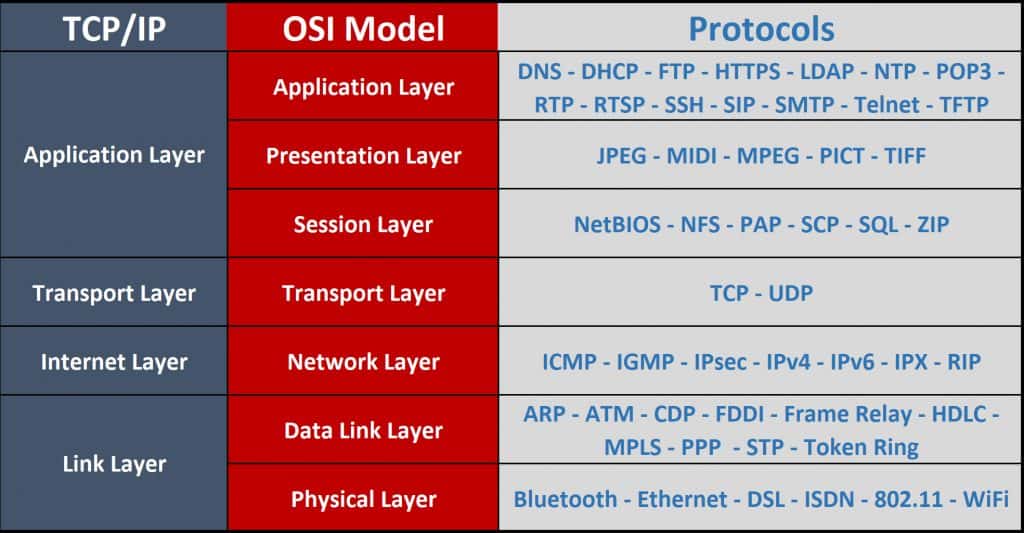Network+ N10-008 Main Domain 1.0 Networking Fundamentals
Sub-objective 1.1 – Compare and contrast the Open Systems Interconnection (OSI) model layers and encapsulation concepts.
The OSI Model
The open systems interconnection (OSI) model is a conceptual framework created by the International Organization for Standardization. It enables disparate communication systems to communicate seamlessly using standard protocols. Simply put, the OSI model provides a standard for heterogeneous computer systems to communicate with each other easily and efficiently. Essentially, it’s a universal language for computer networking. In the age of the Internet (and more local networks as well) it is a mission-critical standard, without the OSI, would there be an internet? Here are the layers:
Layer 1 – Physical Layer
This is the Physical layer on the Network Interface Controller aka Network Interface Card or NIC. It receives the frame and places the actual transmission on the network.
Layer 2 – Data Link Layer
The packet is passed to the Link layer on the NIC, which encapsulates this data with its own header and trailer, creating what is referred to as a frame. The link layer’s frame includes the physical addresses used to find nodes on the local network.
Layer 3 – Network Layer
The Network layer adds a header to the segment. That header identifies the IP address of the destination host as well as the message aka a packet.
Layer 4 – Transport Layer
The Transport layer protocol, typically TCP (for wide area networks or the internet) or UDP (mostly for local area networks) adds a header to the payload. The function of the header is to attach a port number that identifies the application on the destination host. From here on the message, depending on the protocol used, is either a segment or a datagram.
Layer 5 – Session Layer
The Session layer is responsible for establishing maintaining and terminating connections between computers. The connection is called a session. The session layer can also play a role in error handling and connection recovery.
Layer 6 – Presentation Layer
The Presentation layer handles the task of preparing the data and making it acceptable to the Application layer. This preparation includes encryption and decryption, compression, and graphics handling.
Layer 7 – Application Layer
The Application layer is the only OSI layer that interacts with the user. As the user sends an email or browses the internet, the applications they use employ Application layer protocols such as SMTP or HTTP respectively to communicate with the lower OSI layers.
Mnemonic anyone?
One issue is, of course, to just remember all these layers in the right order on exam day. There are a few mnemonics out there listing the first letter of each layer from the bottom up i.e. from layer 7 to 1. Here are three examples of that:
– People Seem To Need Data Processing
– Please Do Not Throw Sausage Pizza Away
– Please Do Not Tell Secret Passwords Anytime
…and now in reverse order:
– All People Seem To Need Data Processing
Pick whichever one works best for you (or make up your own), and on exam date, jot it down immediately on the note pages made available to you at the testing center. That will be one less thing to remember (or mess up) as you go through the exam questions.

Data encapsulation and decapsulation within the OSI model context
In the process of communications between physically connected nodes on an Ethernet network, the data is assembled in a predefined format that conforms to the IEEE 802.3 specification for transmission. The sending node assembles the data in a process called encapsulation and the receiving node then reverses this process. Each Layer communicates directly on the corresponding layer of both nodes.
Most communications need to be broken down into smaller pieces for assembly, transmission, and decapsulation. These are called Protocol Data Units (PDUs).
Here is how the encapsulation process works in practice as it relates to the OSI model:
| Layer | Action | Description |
| 7- Application | Data produced, email, HTTP, file transfer | Data |
| 6- Presentation | Encryption (SSL/TLS), Compression | Data prepared for transmission |
| 5- Session | Begins or ends communication. Supports tunneling and control protocols | Session initiation |
| 4- Transport | Protocol/Port defined. Header added (i.e. TCP/UDP). PDU now becomes a segment. | TCP Segment or UDP datagram created |
| 3- Network | IP Header added creating Packet with IP addressing | Source/Destination addressing and Routing information added |
| 2- Data Link | Ethernet header and footer added creating a Frame. Sending MAC address added. Frame is checked for errors | Ethernet Frame created |
| 1- Physical | Frame is converted to binary bits and transmitted | Frame converted to electrical signal |
Ethernet Frame
| Ethernet Header | IP Header | TCP/UDP Header | Application Data | Ethernet Footer |
That’s it for sub-objective 1.1!
This is one of the shortest articles in this study guide but it will require some hard memorizing so even though it’s short you will need to spend more time than it may seem on it. See you in 1.2 – Explain the characteristics of network topologies and network types.


